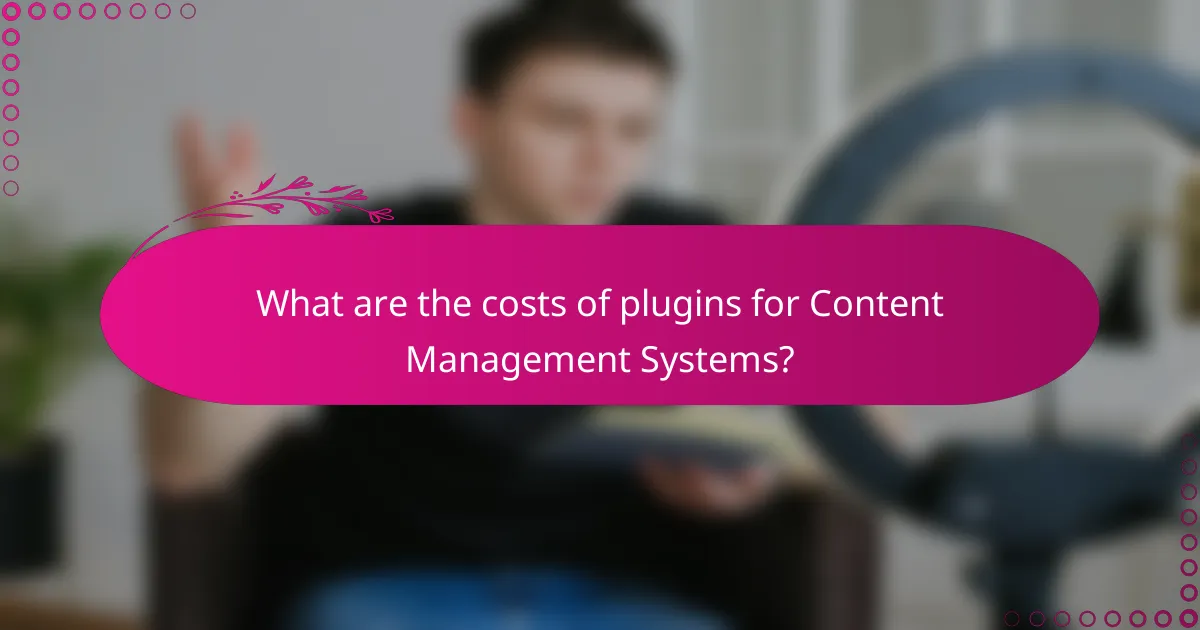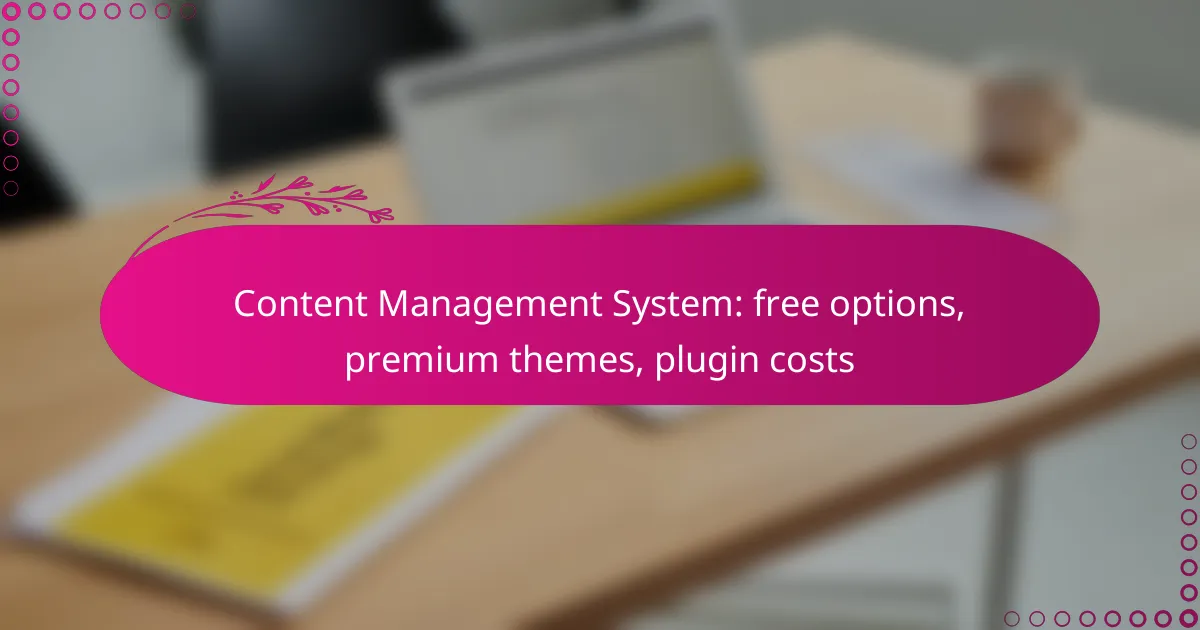Content Management Systems (CMS) offer a variety of free options that cater to different needs, making them ideal for individuals and small businesses. While premium themes can enhance the appearance and functionality of a site, they typically range from $30 to several hundred dollars, influenced by design complexity and support. Additionally, plugin costs vary significantly, with many free options available, but premium plugins can also be priced from a few dollars to several hundred, depending on their features.

What are the best free Content Management Systems in Canada?
The best free Content Management Systems (CMS) in Canada include options that cater to various needs, from blogging to full-fledged websites. These platforms offer essential features without upfront costs, making them accessible for individuals and small businesses.
WordPress.com
WordPress.com is a popular choice for users looking to create blogs or simple websites. It offers a user-friendly interface and a variety of free themes, but users may encounter limitations on customization unless they opt for premium plans.
Consider starting with the free plan to test its capabilities, but be aware that advanced features, such as custom domain names and additional storage, may require a paid upgrade. This CMS is particularly suitable for those focused on content creation without technical hassles.
Wix
Wix is known for its drag-and-drop website builder, making it easy for users to design visually appealing sites. The free version includes Wix branding and limited storage, which may not suit all business needs.
Wix is ideal for small businesses or portfolios that prioritize aesthetics. Users should evaluate whether the limitations of the free plan align with their goals, as upgrading can unlock additional features and remove ads.
Joomla
Joomla is a flexible CMS that caters to more complex websites, offering a balance between ease of use and advanced functionality. It supports various extensions and templates, allowing for significant customization.
This platform is suitable for users with some technical knowledge, as it may require more setup than simpler options. Joomla is a good choice for those looking to build community-driven sites or online applications.
Drupal
Drupal is a powerful CMS favored for its robustness and scalability, making it suitable for larger projects. It offers extensive customization options through modules and themes, but it has a steeper learning curve compared to other platforms.
Ideal for developers or organizations with specific needs, Drupal is best for users who require high levels of control and security. Consider investing time in learning its features if you plan to build a complex site.
Ghost
Ghost is a minimalist CMS focused on professional publishing and blogging. It offers a clean interface and is optimized for speed, making it a great choice for content creators who prioritize writing.
This platform is particularly appealing for users who want a distraction-free environment. While the free version is limited, Ghost’s paid plans provide additional features that enhance user experience and site performance.

What are the costs of premium themes for Content Management Systems?
Premium themes for Content Management Systems (CMS) vary widely in cost, typically ranging from around $30 to several hundred dollars. Factors influencing these prices include the complexity of the design, included features, and the level of support provided by the theme developer.
WordPress premium themes
WordPress premium themes generally cost between $30 and $200. Popular marketplaces like ThemeForest and Elegant Themes offer a variety of options, often with additional features such as customization tools and support. When selecting a theme, consider the long-term value of updates and customer support.
Many themes come with bundled plugins that enhance functionality, which can save you money on additional purchases. However, be cautious of themes that require numerous add-ons, as these can increase overall costs.
Shopify themes
Shopify themes typically range from $140 to $350. These themes are designed specifically for e-commerce and often include features like responsive design and built-in SEO optimization. When choosing a Shopify theme, evaluate how well it aligns with your brand and product offerings.
Shopify also offers a free theme option, but premium themes can provide a more polished look and enhanced functionality. Keep in mind that while the initial cost may be higher, a premium theme can lead to better sales conversions.
Joomla templates
Joomla templates usually cost between $30 and $150. The price often reflects the complexity of the design and the features included, such as responsive layouts and support for various extensions. Look for templates that offer good documentation and customer support to ensure a smoother setup process.
Many Joomla templates are customizable, allowing you to tailor them to your specific needs. However, be aware of potential hidden costs for additional extensions or plugins that may be necessary for full functionality.
Wix premium plans
Wix premium plans, which include access to premium templates, range from around $14 to $49 per month. These plans offer various features such as increased storage, removal of Wix ads, and e-commerce capabilities. Choosing the right plan depends on your website’s needs and expected traffic.
Wix also provides a free plan, but it comes with limitations, including Wix branding and fewer customization options. Investing in a premium plan can enhance your site’s professionalism and user experience, making it worthwhile for serious projects.

What are the costs of plugins for Content Management Systems?
The costs of plugins for Content Management Systems (CMS) can vary widely based on the platform and the specific functionality required. While many plugins are available for free, premium options can range from a few dollars to several hundred, depending on features and support.
WordPress plugins pricing
WordPress plugins can be found in both free and premium versions. Free plugins are often sufficient for basic needs, while premium plugins typically range from $20 to $200 per year, depending on the complexity and support offered. Some popular premium plugins may even have one-time fees, while others operate on a subscription model.
When selecting plugins, consider the ongoing costs for updates and support. It’s also wise to check user reviews and compatibility with your WordPress theme to avoid potential issues.
Shopify app costs
Shopify apps generally come with monthly subscription fees, which can range from $5 to over $300, depending on the app’s functionality. Some apps offer free trials, allowing you to test their features before committing to a subscription.
Keep in mind that while some apps are essential for running an online store, others may provide additional features that can enhance your business. Evaluate whether the potential increase in sales justifies the app’s cost.
Joomla extensions pricing
Joomla extensions are available in both free and paid versions, with premium extensions typically costing between $10 and $150. The price often reflects the level of support and updates provided by the developer.
Before purchasing, assess the extension’s compatibility with your Joomla version and read user feedback. Investing in well-reviewed extensions can save you time and enhance your site’s functionality.

How to choose a Content Management System?
Choosing a Content Management System (CMS) involves assessing your specific needs, budget, and future growth potential. A well-selected CMS can streamline content creation and management, making it easier to maintain a professional online presence.
Evaluate user needs
Start by identifying the primary functions your CMS must support, such as blogging, e-commerce, or portfolio display. Consider the technical skills of your team; some systems are user-friendly for beginners, while others may require advanced knowledge.
Gather input from stakeholders to ensure the CMS meets various user requirements. For instance, if your team needs to collaborate on content, look for features that facilitate teamwork, like version control or multi-user access.
Consider scalability
Scalability is crucial for accommodating future growth. Choose a CMS that can handle increased traffic, additional content, and new features without significant performance drops. Many platforms offer tiered pricing plans that allow you to upgrade as your needs evolve.
Evaluate whether the CMS supports plugins or extensions that can enhance functionality over time. For example, if you anticipate needing advanced SEO tools or e-commerce capabilities, ensure these can be integrated seamlessly without major disruptions.

What are the integration options for Content Management Systems?
Content Management Systems (CMS) offer various integration options that enhance functionality and user experience. These integrations typically fall into two main categories: API integrations and third-party tools, each serving different purposes and providing unique benefits.
API integrations
API integrations allow different software applications to communicate with each other, enabling seamless data exchange and functionality enhancement. Most CMS platforms provide APIs that developers can use to connect external services, such as payment gateways, analytics tools, or social media platforms.
When considering API integrations, evaluate the documentation and support offered by the CMS. Look for well-documented APIs that are easy to use and have active community support. This can significantly reduce development time and costs, making integration smoother.
Third-party tools
Third-party tools are external applications or services that can be integrated into a CMS to extend its capabilities. These tools can range from SEO optimization plugins to e-commerce solutions and marketing automation software. Many CMS platforms have marketplaces where users can find and install these tools easily.
When selecting third-party tools, consider compatibility with your CMS and the specific features you need. Check user reviews and ratings to gauge effectiveness and reliability. Additionally, be mindful of any associated costs, as some tools may require a subscription or one-time payment, which can vary widely based on functionality.
